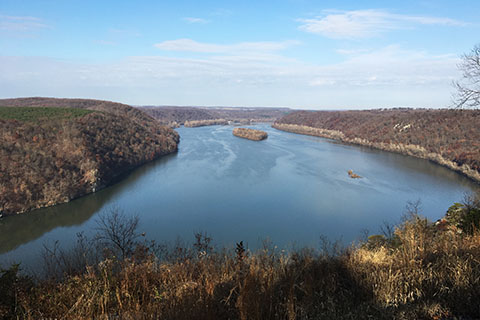DCNR Secretary Cindy Adams Dunn was asked to participate in a Debate in Print in the March-April 2018 issue of The Environmental Forum entitled: “Chesapeake Bay Getting Healthier But New Gains Face Funding Cuts, Policy Challenges.” She argued, “To Clean Up the Bay, Focus on the Land…”
The role of land conservation, forest cover, and public engagement easily gets lost in the challenges of nutrient reductions, Total Maximum Daily Loads (TMDLs), and Chesapeake Bay Program agreements. Yet this work emerges as critical as we better understand the roles riparian buffers, conserved forest land, and green infrastructure play in assisting with the bay ecosystem’s resiliency and pollution absorbing capacity.
The importance of forests to clean water is well understood, and increasingly important in a warming climate. DCNR, and many partners, manages public lands and forests to clean and filter water, and encourages conservation actions on private lands by engaging with the public who make decisions and choices that impact local waters and the bay.
Stream Buffers are a Water Quality Best Management Practice

One of the best places to restore forests are at the edge of streams. The Bay Program credits forest riparian buffers as one of the most effective best management practices for removing nitrogen, phosphorus, and sediment.
These practices are supported by the U.S. Environmental Protection Agency (EPA), U.S. Department of Agriculture (USDA), and all agencies in Pennsylvania directly involved with bay clean-up: DCNR, and the departments of Environmental Protection and Agriculture.
As Pennsylvania develops its Watershed Implementation Plan, forest riparian buffers are central. To meet the Chesapeake Bay TMDL, we are working collectively to add 95,000 new forested buffer acres by 2025. Federal financial and program support will be critical.
While supporting the federal CREP program, DCNR created an alternative approach that provides more flexibility to landowners, especially with Amish and Mennonite farmers. This approach funds buffers designed to allow some income-producing trees and shrubs such as nuts, berries, willows, and energy crops. It will attract landowners who might not qualify for or want to enroll in the Conservation Reserve Enhancement Program (CREP), and motivate them to keep their buffer in place long-term as it produces income. So far, Pennsylvania is investing more than $4 million in Keystone and PENNVEST dollars in this program.
But we also need to keep the stream buffers and forested lands we already have.
Forest Land Conservation
“Penn’s Woods” is 59 percent forested, with 17 million acres of forestland. DCNR manages 2.6 million acres, much of it in the Chesapeake Bay watershed.
Despite the large public land ownership in the headwaters, 75 percent of Pennsylvania’s forested lands are privately owned, and are becoming increasingly fractured and parcelized as children inherit large tracts and divide them.
For the Susquehanna and other waterways to improve, we need to protect the existing forests, and expand forest land protection and conservation. The Chesapeake Conservation Partnership is bringing together agencies and non-profits to secure support for this across the watershed.
The U.S. Forest and National Park services both provide critical funds, but unfortunately the president’s budget cut the Land and Water Conservation Fund, and we’re relying on Congress to restore it.
Working Woodlands
DCNR has been experimenting with a “working woodlands” approach to conserving forestland. Owned by large timber organizations and watershed authorities, these lands are rapidly changing hands and are increasingly subdivided and vulnerable to development.
By encouraging conservation investors to purchase these lands and continue timbering sustainably, they remain in forest cover and support jobs, as well as water quality, wildlife, carbon sequestration, and many other benefits.
DCNR is in discussions to facilitate permanent conservation easements on these working woodlands to prevent subdivision and appease local officials who often oppose state ownership of large parcels.
Of course, meeting Pennsylvania’s commitment to the bay won’t rely solely on conserving forests. Fortunately, DCNR works in partnership with our state Environmental Protection and Agriculture agencies on the wide range of best management practices being adopted by communities, farmers, and landowners.
Engaging Citizens at the Landscape Level

In the long run, the major motivator to engage local citizens is their local rivers, streams, and landscapes. DCNR leads a proactive approach to engaging people with land and water through our Conservation Landscapes program.
The Susquehanna Riverlands in Lancaster and York counties is one good example, focused on the stunningly beautiful lower gorge of the Susquehanna River. The partnerships enhance the natural assets through federal, state, and local investments in land conservation, trail, and park development, interpretation, education, and tourism.
Continued financial and programmatic support from National Park Service, EPA, and USDA U.S. Forest Service programs is essential to support this work and keep momentum going.
Pennsylvania state government, local government, and non-profits are committed and doing established, productive work, so the steady support of federal partners is critical to leverage local investments.
I am enthusiastically supportive of the Chesapeake Bay Program because it gives an extra impetus for those of us up in the watershed to conserve land and forests, clean up streams and rivers, and connect our public to these incredible assets.
We need continued federal resources to accomplish this.
For more information about forest buffers along waterways, explore DCNR's resources.